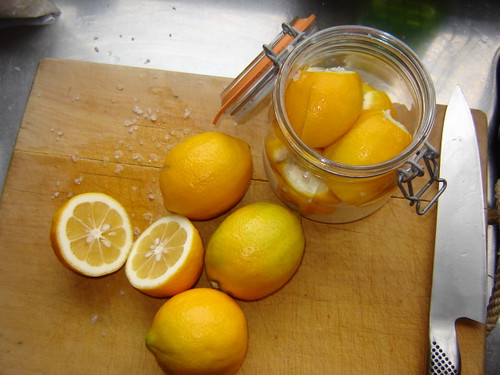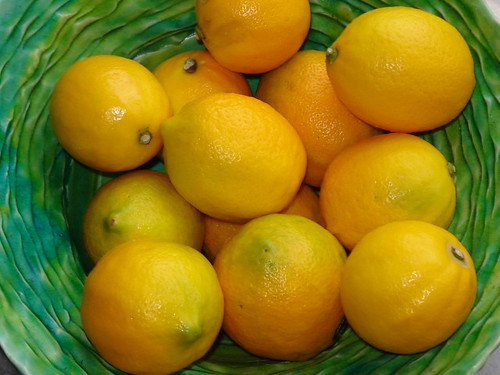The weather here in Christchurch is beyond bleak at present – day after day after day of cold, grey miserable days. Now in my 16th winter in Christchurch, this feels like the worst so far. It did occur to me that this could be an age thing – that maybe each year older I start to feel the cold a little more – but since people half my age are complaining about the cold as well, I can thankfully avoid putting the chill in my bones down to decrepitude just yet.
One of the joys of winter, however, is an abundance of citrus fruit – particularly lemons. Not that they grow particularly well here in Christchurch, but at least at this time of year we can get New Zealand grown lemons as opposed to Californian.
I grew up in Auckland, where nearly every home had a backyard lemon tree – a city where no-one ever bought lemons! If you didn’t have a lemon tree yourself, at the very least your neighbour did. Lemons were plentiful year round, and if you asked your neighbour for a lemon, you were usually armed with a large brown paper bag (these days more likely a plastic supermarket bag) and told to go help yourself – it being fully expected that you would take as many as the bag would hold, not just the one lemon that you need for tonight’s gin & tonic.
In my family, the lemons came from a magnificent Meyer lemon tree which stood in the centre of Nana’s backyard, and grapefruit came from our own garden. Cartons full of both would get shipped off down to the South Island to Dad’s sisters, and much of that produce would get turned into Aunty Joan’s exceptional marmalade (perhaps I can wangle the recipe out of her for a later post).
So it was a big shock to me when I moved to Christchurch and discovered that here you had to buy lemons!! And for a long time I just couldn’t do it – I refused to buy lemons, which was difficult because I love them and use them a lot – I mean just about any dish can be enhanced with a spritzing of lemon juice or a sprinkling of grated rind – right? But for a long time I went without, buying only the occasional “essential” lemon, and really resenting it.
I’ve long since given up resisting and buy them freely now, but all of a sudden I feel quite obsessed with them. There’s something about the sight of those bright yellow orbs that fills me with joy on these bleak, grey days, and I feel as though I can’t get enough of them. They offer the promise of warmth and sunshine, and I can’t seem to go shopping without buying a bag full of them. So now I am preserving lemons, see directions below (I love the delicious salty tang and texture that these bring to salads, dressings, tagines, couscous, etc), and and have plans for some jars of lemon curd and lemon sorbet on the weekend.
But the thought occurs to me … is the idea of preserving & storing food in conflict with the yogic principle of aparigraha (non-greed, non-grasping, non-hoarding)? The concept of aparigraha is that we should only take or keep that which is necessary, and that hoarding and holding on to a lot of stuff that we don’t “need” suggests we don’t have the faith that we will be able to provide what we require when the need arises. Certainly back in the times of our hunter/gatherer forbears preserving and storing food during times of plenty was essential to survival during times when food supplies were not available. And it is not that long ago that lack of refrigeration and modern transportation made the preserving of food at the very least practical. But today, when we can get pretty much anything we need, any time, is it just hoarding?
Certainly, I think it is infinitely better to be buying produce while it is in season and plentiful, and preserving it to use when it is not, than to be buying out of season produce that has travelled half way round the world to get to our supermarkets. But, nevertheless, if I’m to adhere strictly to this yogic principle, should I be doing without things that have been preserved, dried, frozen or stored for a time when they are not available, and consuming only what is fresh and available right now? I think the raw foodists would agree, but I don’t think I’m ready to make that leap just yet. I can adhere to buying fresh food in season, and as much as possible locally sourced goods, but I just can’t imagine life without dozens of things in my pantry, such as tinned tomatoes, dried beans & pulses, grains, jams, and of course preserved lemons – most of which are very useful, but I’m not sure I can say how necessary they are. It is easier for me to clear out my wardrobe than the pantry, so at the moment my pantry seems the very antithesis of an “aparigrahic” (probably not a real word) place. I have a long way to go, but …
I’ve made a start today by getting rid of that jar of Red Pepper Relish that has been languishing at the back of the pantry for eight years! An item I purchased even though I don’t like relish, but because it looked so pretty! I’ve replaced that relish with the jar of preserved lemons I made today, which I know I will use – I’m okay with that.
Preserved Lemons Recipe
lemons
coarse sea salt
sterilised preserving jars
Clean lemons well, especially giving them a good scrub to remove any waxy coating if you are using store bought lemons.
Cut a small slice from the stalk end so that you can stand the lemon upright on your chopping board. Then make two vertical cuts, at right angles to each other, down through the lemon to about 1cm from the bottom – take care not to cut all the way through. Your lemon should now be in quarters but still attached at the bottom.
Gently squeeze the lemon open and fill the cuts with as much salt as possible. Then push the cuts back together and holding the salt in as best you can put the lemons into the sterlised jar. Squash as many lemons as you can, pushing them in firmly so that they release some of their juice as you do so, and adding more salt between each layer if you're filling a large jar.
No need to add more juice at this stage, as the lemons will continue to release juice during the pickling process. Seal jar and then store in a cool place, shaking every day (to help dissolve and distribute the salt) for a week. After a week, now top up the jar with extra lemon juice if necessary, then return to a cool, dark place and leave them alone for a month.
Once opened, store in the fridge.
Once opened, store in the fridge.
To use: Remove and discard the pulpy flesh; rinse and dry the rind, then use as required.



0 comments:
Post a Comment
Thanks for stopping by and taking the time to leave a comment. I love hearing from you and your comments are like gold to me. Your comment will be visible as soon as it has been approved.